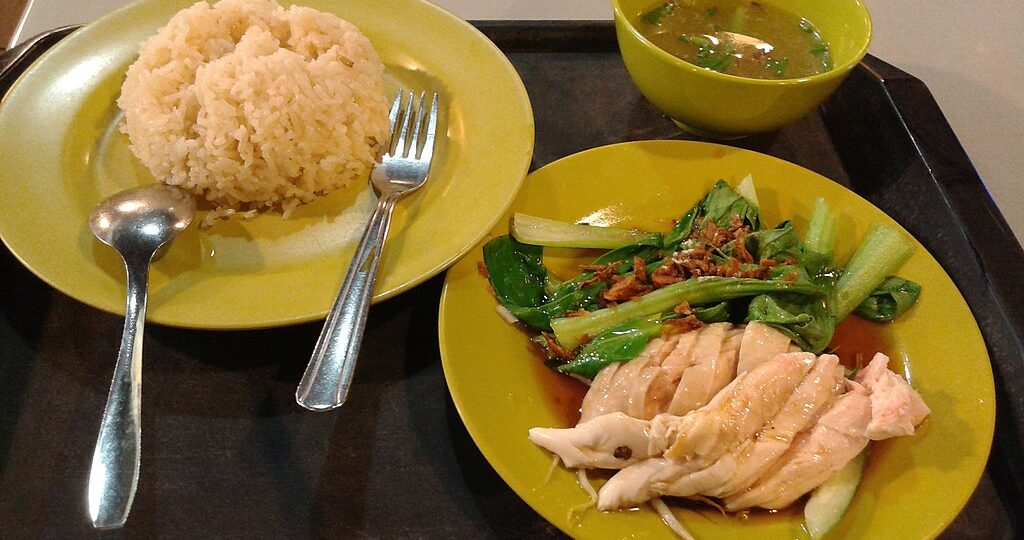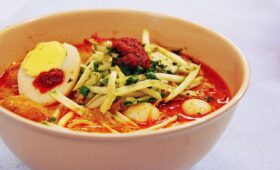Introduction to Hainanese Chicken Rice
Origin and Cultural Significance
Hainanese Chicken Rice, a beloved dish in Singapore, originated in the Hainan province in southern China. It was brought to Singapore by early Chinese immigrants, particularly the Hainanese people, who settled on the island.
This culinary gem is not only a delicious meal but also holds immense cultural significance for both locals and visitors. In its early days, Hainanese Chicken Rice was considered a humble peasant dish.
However, over time it gained popularity and became an iconic part of Singapore’s culinary landscape. Today, it is widely recognized as one of the nation’s national dishes and is often showcased as a must-try food for tourists.
Popular Dish in Singapore’s Culinary Scene
In the vibrant streets and bustling hawker centers of Singapore, Hainanese Chicken Rice stands out as one of the most popular dishes. It has become an integral part of the local cuisine, enjoyed by people from all walks of life – from office workers seeking a quick lunch to families indulging in a hearty dinner.
What makes this dish so appealing is its simplicity combined with exquisite flavors. The succulent poached chicken served with fragrant rice and flavorful dipping sauces creates a perfect harmony on the taste buds.
Whether you’re dining at upscale restaurants or grabbing this delectable meal from street-side stalls, it’s hard to resist the allure of Hainanese Chicken Rice. With its rich history and popularity among locals and travelers alike, Hainanese Chicken Rice has become an emblematic representation of Singapore’s multicultural food scene.
It showcases how diverse influences can come together to create something truly delightful for both palate and soul. So if you find yourself strolling through the streets of Singapore, don’t miss out on this iconic dish that captures the essence of the city’s culinary heritage.
The Perfectly Poached Chicken
The traditional method of poaching
When it comes to creating the perfect Hainanese chicken rice, the process of poaching the chicken plays a crucial role. The traditional method involves simmering a whole chicken in a flavorful broth seasoned with ginger, garlic, and other aromatics.
The gentle heat ensures that the meat remains tender and succulent while absorbing the fragrant flavors from the broth. To begin, the chicken is thoroughly cleaned and then gently lowered into a pot of boiling water or broth.
It is essential to maintain a consistent temperature throughout to prevent overcooking or undercooking. This slow and controlled poaching process allows the natural flavors of the chicken to shine through while maintaining its moist texture.
Importance of using quality chicken
The quality of the chicken used for Hainanese chicken rice cannot be overstated. Opting for fresh, high-quality poultry is paramount in achieving an outstanding dish.
Locally sourced free-range chickens are often preferred due to their superior taste and texture compared to intensively farmed alternatives. Freshness plays a vital role since older birds tend to have tougher meat that is less flavorful.
Additionally, free-range chickens develop more muscle tone due to their active lifestyle, resulting in firmer flesh that retains its juiciness during cooking. So when choosing your poultry, investing in quality will undoubtedly elevate your Hainanese chicken rice experience.
Secret to achieving tender and juicy meat
The secret behind achieving perfectly tender and juicy Hainanese chicken lies not only in proper poaching but also in post-cooking techniques. Once cooked, it’s crucial to transfer the poached bird immediately into an ice bath or cold water bath for several minutes.
This rapid cooling process helps stop further cooking and preserves its inherent moisture. After cooling down, the chicken is traditionally hung to air-dry or brushed with oil and chilled, allowing the skin to tighten and develop a coveted gelatinous texture.
This additional step imparts a delicate silkiness to the meat while ensuring its succulence. When sliced, each piece showcases a glistening sheen and tender flesh that epitomizes the essence of Hainanese chicken rice.
By following these techniques, you can achieve a perfectly poached chicken for your Hainanese chicken rice dish. Remember, patience and attention to detail are key in attaining that coveted tenderness, resulting in a truly exceptional culinary experience.
Fragrant Rice, the Unsung Hero
When it comes to Hainanese chicken rice, the spotlight often falls on the succulent poached chicken and tantalizing dipping sauces. However, let’s not overlook the unsung hero of this dish – the fragrant rice.
It is crucial to have rice that doesn’t just serve as a bland accompaniment but adds its own burst of flavor and aroma to the overall experience. The secret lies in a unique cooking technique that elevates simple grains into a culinary masterpiece.
Unique cooking technique for flavorful rice
The cooking technique employed for Hainanese chicken rice is known as “double-boiling.” It involves first stir-frying the uncooked rice in fragrant oil with minced garlic and ginger until each grain is coated evenly. Then, water or chicken broth is added along with pandan leaves for an exquisite aroma. The mixture is brought to a boil and then simmered until all the liquid is absorbed, resulting in perfectly cooked, fluffy grains infused with delightful flavors.
Essential ingredients for aromatic rice
Apart from its cooking method, several key ingredients contribute to the irresistible fragrance of Hainanese chicken rice. Firstly, pandan leaves are essential for their distinct sweet aroma reminiscent of vanilla and coconut. These leaves are usually tied into knots before being added to the pot during cooking.
Secondly, minced garlic provides a savory note while ginger lends a subtle warmth that complements both the chicken and rice perfectly. High-quality chicken broth or water enhances the taste profile even further.
How to achieve the perfect texture
Achieving just the right texture for Hainanese chicken rice can be quite tricky but well worth it when done right. The ideal consistency lies in making each grain separate and fluffy, without clumping or becoming mushy. To achieve this, it is crucial to use the correct rice variety, such as jasmine rice, which is known for its fragrant aroma and ability to hold its shape.
Additionally, the cooking time and ratio of water to rice should be carefully monitored. Too much water can make the rice soggy, while too little can result in undercooked grains.
Dipping Sauces that Elevate the Dish
Ginger sauce: The zesty companion
When it comes to Hainanese chicken rice, one cannot overlook the importance of the zesty ginger sauce. This sauce adds a burst of flavor and enhances the overall taste of the dish. The ingredients for this delightful condiment are simple yet powerful: fresh ginger, garlic, chicken broth, and a touch of sesame oil.
To prepare this delectable sauce, start by finely grating a generous amount of fresh ginger. Squeeze out the juice from the grated ginger using a sieve or cheesecloth into a bowl.
Add minced garlic and mix them together to form a fragrant paste. Then, heat up some chicken broth until it is hot but not boiling, and pour it over the ginger-garlic mixture to create a flavorful blend.
Drizzle in some aromatic sesame oil for that extra kick. The role of this zesty companion goes beyond adding flavor – it complements the succulent poached chicken by cutting through its richness with its vibrant spiciness.
The gingery tang also helps cleanse your palate between bites, ensuring each mouthful is as enjoyable as the first. Additionally, ginger has numerous health benefits such as aiding digestion and boosting immunity, making this sauce not only delicious but also beneficial for your well-being.
Chili sauce: The fiery condiment
If you’re someone who craves an extra kick in your culinary adventures, then chili sauce is your fiery companion in Hainanese chicken rice heaven. Made from red chilies, garlic cloves, lime juice, sugar, and salt; this vibrant condiment adds that much-needed spicy element to elevate your dining experience.
Preparation starts with grinding red chilies and garlic cloves into a fine paste using either a mortar and pestle or a food processor. This paste is then mixed with a squeeze of fresh lime juice to balance the flavors.
For a touch of sweetness, a pinch of sugar is added, and salt is thrown in to enhance all the other flavors. Voila!
You have yourself a tantalizing chili sauce. The spice level variations for this condiment are as diverse as the people enjoying it.
Some prefer a milder version with just a hint of spice, while others embrace the heat and go for an extra fiery kick in their sauce. Regardless of your preference, this versatile sauce can be customized to suit your taste buds.
In Singaporean cuisine, chili takes on an iconic role and holds cultural significance. It adds depth and heat to many local dishes, Hainanese chicken rice being no exception.
The marriage between succulent poached chicken and punchy chili sauce creates a harmonious union that reflects the multicultural influence seen in Singapore’s culinary landscape. Note: Remember that HTML tags are not included in the final article output but are used here for clarity purposes only.
Complementary Side Dishes
Soup: Clear broth or robust flavors?
When it comes to serving Hainanese chicken rice, the selection of soup plays a crucial role in completing the dining experience. While some prefer a clear and light chicken broth to cleanse their palate, others opt for a more flavorful and robust option. The traditional chicken broth recipe involves simmering chicken bones with aromatic herbs like pandan leaves, ginger, and garlic.
This creates a delicate yet comforting soup that perfectly complements the main dish. The slow cooking process ensures that all the flavors are extracted, resulting in a rich and nourishing broth.
For those seeking an alternative to traditional chicken broth, laksa soup is a popular choice. This creamy and spicy concoction originates from Peranakan cuisine, which combines Chinese and Malay influences.
Laksa soup is made with coconut milk, curry paste, dried shrimp, and various spices that give it its distinctive aroma and taste. The addition of this vibrant soup alongside Hainanese chicken rice adds an extra layer of complexity to each bite.
Vegetable accompaniments: Freshness on the side
While Hainanese chicken rice takes center stage in this culinary delight, fresh vegetables serve as essential accompaniments that bring balance to the meal. Common choices include blanched greens such as bok choy or kai lan (Chinese broccoli).
These vegetables provide a refreshing contrast to the savory flavors of the poached chicken and fragrant rice. They are lightly blanched to retain their crispness while maintaining their natural vibrant color.
For those looking for unique variations in vegetable accompaniments, pickled vegetables are an interesting choice. These tangy delights infuse an additional burst of flavor into each mouthful.
Pickled cucumber slices or daikon radish are commonly served alongside Hainanese chicken rice. The tanginess of the pickles adds a refreshing and zesty element, cutting through the richness of the dish and leaving you craving for more.
So, whether you prefer a clear and nourishing soup or an aromatic and spicy one, along with blanched greens or tangy pickled vegetables, these complementary side dishes elevate the experience of Hainanese chicken rice to new heights. They provide a delightful contrast to the main components, adding depth and variety to each mouthful.
Regional Variations of Hainanese Chicken Rice
Malaysian style: Similarities and differences
Regarding Hainanese chicken rice, our neighbors in Malaysia have put their unique twist on this beloved dish. The Malaysian version shares some similarities with Singapore’s rendition, but there are distinct differences that make it stand out.
One notable difference is the use of different dipping sauces. While Singaporeans enjoy their chicken rice with ginger sauce and chili sauce, Malaysians often serve it with a tangy soy-based sauce that adds a delightful tanginess to the dish.
Another distinctive aspect of Malaysian-style Hainanese chicken rice is the variety of condiments available. In addition to the usual cucumber slices and cilantro garnish, you might find additional toppings like fried shallots or even a side of mixed vegetables.
These added elements give Malaysian Hainanese chicken rice an extra burst of flavor and texture. The preparation method for chicken in Malaysia also differs slightly from its Singaporean counterpart.
While both countries poach their chickens, Malaysians often marinate theirs in a mixture of soy sauce and five-spice powder before cooking. This imparts a unique flavor profile to the meat, making it richer and more aromatic.
Thai style: Influences from neighboring countries
Thailand’s take on Hainanese chicken rice showcases the country’s culinary prowess by incorporating elements from neighboring nations. Thai-style Hainanese chicken rice has a distinct blend of flavors that combines influences from Chinese cuisine with Thai ingredients and techniques. One significant difference is in the preparation of the rice itself.
Instead of using plain water as traditional recipes call for, Thais infuse their jasmine rice with pandan leaves or lemongrass during cooking. This imparts a subtle fragrance to the grains, elevating its aroma.
Thai-style Hainanese chicken rice also features a unique condiment known as “nam jim.” This spicy dipping sauce is typically made with chilies, garlic, fish sauce, lime juice, and sometimes a hint of palm sugar. The nam jim adds a fiery kick to the dish and complements the milder flavors of the poached chicken.
Moreover, Thai-style Hainanese chicken rice often includes additional side dishes such as pickled vegetables or crispy pork belly. These additions provide contrasting textures and flavors that create a diverse dining experience.
Chinese style: Regional adaptations
In China, different regions have their own adaptations of Hainanese chicken rice. Each variation showcases the local culinary preferences and ingredients. For instance, in Guangdong province (where Hainanese chicken rice originated), they take pride in using free-range chickens for extra succulence and flavor.
In Fujian province, the emphasis is on strong aromatic components. This means that the poached chicken is often flavored with garlic and other fragrant spices to create a more robust taste profile.
Meanwhile, in the northern parts of China like Beijing or Tianjin, you’ll find an interesting twist on this famous dish called “Hainanese Chicken Rolls.” Instead of serving it as separate components like Singapore or Malaysia, they wrap the tender poached chicken along with fragrant rice in thin pancakes. This unique presentation gives it an added dimension both visually and texturally.
Overall, these regional adaptations highlight how versatile Hainanese chicken rice can be while celebrating each region’s distinct culinary traditions. Whether it’s through variations in flavorings or innovative plating techniques, these adaptations showcase how this iconic dish has evolved to cater to different tastes across borders.
Iconic Hainanese Chicken Rice Stalls in Singapore
Tian Tian Hainanese Chicken
The Jewel of Maxwell Food Centre Tian Tian Hainanese Chicken is an institution when it comes to this beloved dish. Nestled within the bustling Maxwell Food Centre, this humble stall has gained international acclaim and attracts long queues of hungry patrons every day. The secret to their success lies in their unwavering dedication to quality and authenticity.
At Tian Tian, the chicken is impeccably poached, resulting in tender and succulent meat that practically melts in your mouth. They source only the finest free-range chickens, ensuring a superior flavor and texture. The fragrant rice is cooked to perfection with just the right balance of pandan leaves and garlic, creating a delightful aroma that permeates the air.
What sets Tian Tian’s chicken rice apart is its homemade sauces. Their ginger sauce strikes a perfect harmony between tangy and spicy notes, complementing the chicken beautifully. And their chili sauce? It’s like a fiery dance on your taste buds, with its explosive blend of chili peppers, garlic, and vinegar that adds an irresistible kick to every bite. With its unbeatable combination of flavors, it’s no wonder why locals and tourists alike flock to Tian Tian for an unforgettable culinary experience.
Conclusion
Hainanese chicken rice is more than just a dish – it’s an embodiment of Singapore’s rich culinary heritage and multicultural influences. From its tender poached chicken to its fragrant rice and tantalizing sauces, this iconic dish has captivated hearts around the world. Whether you find yourself indulging at renowned stalls like Tian Tian Hainanese Chicken or exploring lesser-known gems tucked away in hawker centers across Singapore, you’ll be treated to a symphony of flavors that will leave you craving more.
The magic of Hainanese chicken rice lies in its simplicity and the passion poured into every step of its preparation. So next time you have the chance, don’t miss the opportunity to savor this gastronomic delight.
Let Hainanese chicken rice transport you to the vibrant streets of Singapore, where culinary wonders await at every turn. Indulge in this beloved dish and embrace the joy it brings – as every mouthful is a celebration of culture, community, and the universal language of good food.


